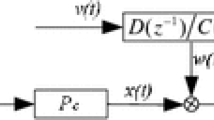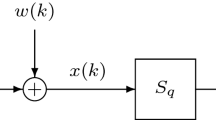Abstract
This paper presents an identification algorithm for Box–Jenkins systems by combining the auxiliary model identification idea and the gradient search principle. The proposed algorithm can estimate all unknown parameters of the Box–Jenkins systems. Furthermore, to improve the convergence rate of the stochastic gradient algorithm, a modified stochastic gradient algorithm is given. The simulation results indicate that the proposed algorithm can work well.

Similar content being viewed by others
References
J. Chen, F. Ding, Modified stochastic gradient algorithms with fast convergence rates. J. Vib. Control 17(9), 1281–1286 (2011)
J. Chen, Y. Zhang, R.F. Ding, Auxiliary model based multi-innovation algorithms for multivariable nonlinear systems. Math. Comput. Model. 52(9–10), 1428–1434 (2010)
F. Ding, Several multi-innovation identification methods. Digit. Signal Process. 20(4), 1027–1039 (2010)
F. Ding, Decomposition based fast least squares algorithm for output error systems. Signal Process. 93(5), 1235–1242 (2013)
F. Ding, Coupled-least-squares identification for multivariable systems. IET Control Theory Appl. 7 (2013). doi:10.1049/iet-cta.2012.0171
F. Ding, Gradient-based and least-squares-based iterative algorithms for Hammerstein systems using the hierarchical identification principle. IET Control Theory Appl. 7 (2013). doi:10.1049/iet-cta.2012.0313
F. Ding, Hierarchical multi-innovation stochastic gradient algorithm for Hammerstein nonlinear system modeling. Appl. Math. Model. 37(4), 1694–1704 (2013)
F. Ding, Two-stage least squares based iterative estimation algorithm for CARARMA system modeling. Appl. Math. Model. 37(7), 4798–4808 (2013)
F. Ding, T. Chen, Combined parameter and output estimation of dual-rate systems using an auxiliary model. Automatica 40(10), 1739–1748 (2004)
F. Ding, T. Chen, Parameter estimation of dual-rate stochastic systems by using an output error method. IEEE Trans. Autom. Control 50(9), 1436–1441 (2005)
F. Ding, T. Chen, Hierarchical identification of lifted state-space models for general dual-rate systems. IEEE Trans. Circuits Syst. I, Regul. Pap. 52(6), 1179–1187 (2005)
F. Ding, T. Chen, Performance analysis of multi-innovation gradient type identification methods. Automatica 43(1), 1–14 (2007)
J. Ding, F. Ding, The residual based extended least squares identification method for dual-rate systems. Comput. Math. Appl. 56(6), 1479–1487 (2008)
F. Ding, J. Ding, Least squares parameter estimation with irregularly missing data. Int. J. Adapt. Control Signal Process. 24(7), 540–553 (2010)
F. Ding, X.P. Liu, H.Z. Yang, Parameter identification and intersample output estimation for dual-rate systems. IEEE Trans. Syst. Man Cybern., Part A, Syst. Hum. 38(4), 966–975 (2008)
F. Ding, X.P. Liu, G. Liu, Auxiliary model based multi-innovation extended stochastic gradient parameter estimation with colored measurement noises. Signal Process. 89(10), 1883–1890 (2009)
F. Ding, L. Qiu, T. Chen, Reconstruction of continuous-time systems from their non-uniformly sampled discrete-time systems. Automatica 45(2), 324–332 (2009)
F. Ding, G. Liu, X.P. Liu, Partially coupled stochastic gradient identification methods for non-uniformly sampled systems. IEEE Trans. Autom. Control 55(8), 1976–1981 (2010)
F. Ding, X.P. Liu, G. Liu, Gradient based and least-squares based iterative identification methods for OE and OEMA systems. Digit. Signal Process. 20(3), 664–677 (2010)
F. Ding, X.P. Liu, G. Liu, Multi-innovation least squares identification for linear and pseudo-linear regression models. IEEE Trans. Syst. Man Cybern., Part B, Cybern. 40(3), 767–778 (2010)
J. Ding, F. Ding, X.P. Liu, G. Liu, Hierarchical least squares identification for linear SISO systems with dual-rate sampled-data. IEEE Trans. Autom. Control 56(11), 2677–2683 (2011)
F. Ding, G. Liu, X.P. Liu, Parameter estimation with scarce measurements. Automatica 47(8), 1646–1655 (2011)
F. Ding, X.P. Liu, G. Liu, Identification methods for Hammerstein nonlinear systems. Digit. Signal Process. 21(2), 215–238 (2011)
F. Ding, Y.J. Liu, B. Bao, Gradient based and least squares based iterative estimation algorithms for multi-input multi-output systems. Proc. Inst. Mech. Eng., Part I, J. Syst. Control Eng. 226(1), 43–55 (2012)
J. Feng, Z. Wang, M. Zeng, Recursive robust filtering with finite-step correlated process noises and missing measurements. Circuits Syst. Signal Process. 30(6), 1355–1368 (2011)
L.L. Han, F. Ding, Parameter estimation for multirate multi-input systems using auxiliary model and multi-innovation. J. Syst. Eng. Electron. 21(6), 1079–1083 (2010)
H.Q. Han, L. Xie, X.G. Liu, Hierarchical least squares based iterative identification for multivariable systems with moving average noises. Mathematical and Computer Modelling 51(9–10), 1213–1220 (2010)
S.C. Kadu, M. Bhushan, R.D. Gudi, Optimal sensor network design for multirate systems. J. Process Control 18(6), 594–609 (2008)
D. Li, S.L. Shah, T. Chen, Analysis of dual-rate inferential control systems. Automatica 38(6), 1053–1059 (2002)
J.H. Li, F. Ding, G.W. Yang, Maximum likelihood least squares identification method for input nonlinear finite impulse response moving average systems. Math. Comput. Model. 55(3–4), 442–450 (2012)
Y.J. Liu, Y.S. Xiao, X.L. Zhao, Multi-innovation stochastic gradient algorithm for multiple-input single-output systems using the auxiliary model. Appl. Math. Comput. 215(4), 1477–1483 (2009)
Y.J. Liu, L. Xie et al., An auxiliary model based recursive least squares parameter estimation algorithm for non-uniformly sampled multirate systems. Proceedings of the Institution of Mechanical Engineers, Part I. Proc. Inst. Mech. Eng., Part I, J. Syst. Control Eng. 223(4), 445–454 (2009)
Y.J. Liu, J. Sheng, R.F. Ding, Convergence of stochastic gradient algorithm for multivariable ARX-like systems. Comput. Math. Appl. 59(8), 2615–2627 (2010)
Y.J. Liu, D.Q. Wang et al., Least-squares based iterative algorithms for identifying Box–Jenkins models with finite measurement data. Digit. Signal Process. 20(5), 1458–1467 (2010)
Y.J. Liu, L. Yu et al., Multi-innovation extended stochastic gradient algorithm and its performance analysis. Circuits Syst. Signal Process. 29(4), 649–667 (2010)
Y.J. Liu, F. Ding, Y. Shi, Least squares estimation for a class of non-uniformly sampled systems based on the hierarchical identification principle. Circuits Syst. Signal Process. 31(6), 1985–2000 (2012)
S. Nakamori, A. Hermoso-Carazo, J. Linares-Pérez, Suboptimal estimation of signals from uncertain observations using approximations of mixtures. Digit. Signal Process. 17(1), 4–16 (2007)
M.F. Sägfors, H.T. Toivonen, H ∞ and LQG control of asynchronous sampled-data systems. Automatica 33(9), 1663–1668 (1997)
Y. Shi, F. Ding, T. Chen, Multirate crosstalk identification in xDSL systems. IEEE Trans. Commun. 54(10), 1878–1886 (2006)
A.K. Tanc, A.H. Kayran, Maximum entropy power spectrum estimation for 2-D multirate systems. Circuits Syst. Signal Process. 31(1), 271–281 (2012)
R.M. Udrea, D.N. Vizireanu, S. Ciochina, An improved spectral subtraction method for speech enhancement using a perceptual weighting filter. Digit. Signal Process. 18(4), 581–587 (2008)
R.M. Udrea, D.N. Vizireanu, S. Ciochina, S. Halunga, Nonlinear spectral subtraction method for colored noise reduction using multi-band Bark scale. Signal Process. 88(5), 1299–1303 (2008)
D.N. Vizireanu, S.V. Halunga, Simple, fast and accurate eight points amplitude estimation method of sinusoidal signals for DSP based instrumentation. J. Instrum. 7, P04001 (2012)
D.N. Vizireanu, R.O. Preda, Is “five-point” estimation better than “three-point” estimation? Measurement 46(1), 840–842 (2013)
J. Vörös, Modeling and identification of systems with backlash. Automatica 46(2), 369–374 (2010)
D.Q. Wang, Least squares-based recursive and iterative estimation for output error moving average systems using data filtering. IET Control Theory Appl. 5(14), 1648–1657 (2011)
D.Q. Wang, F. Ding, Input-output data filtering based recursive least squares parameter estimation for CARARMA systems. Digit. Signal Process. 20(4), 991–999 (2010)
D.Q. Wang, F. Ding, Performance analysis of the auxiliary models based multi-innovation stochastic gradient estimation algorithm for output error systems. Digit. Signal Process. 20(3), 750–762 (2010)
D.Q. Wang, F. Ding, Least squares based and gradient based iterative identification for Wiener nonlinear systems. Signal Process. 91(5), 1182–1189 (2011)
D.Q. Wang, F. Ding, Hierarchical least squares estimation algorithm for Hammerstein–Wiener systems. IEEE Signal Process. Lett. 19(12), 825–828 (2012)
D.Q. Wang, G.W. Yang, R.F. Ding, Gradient-based iterative parameter estimation for Box–Jenkins systems. Comput. Math. Appl. 60(5), 1200–1208 (2010)
W. Wang, F. Ding, J.Y. Dai, Maximum likelihood least squares identification for systems with autoregressive moving average noise. Appl. Math. Model. 36(5), 1842–1853 (2012)
D.Q. Wang, R. Ding, X.Z. Dong, Iterative parameter estimation for a class of multivariable systems based on the hierarchical identification principle and the gradient search. Circuits Syst. Signal Process. 31(6), 2167–2177 (2012)
L. Xie, Y.J. Liu et al., Modelling and identification for non-uniformly periodically sampled-data systems. IET Control Theory Appl. 4(5), 784–794 (2010)
Z.N. Zhang, F. Ding, X.G. Liu, Hierarchical gradient based iterative parameter estimation algorithm for multivariable output error moving average systems. Comput. Math. Appl. 61(3), 672–682 (2011)
Acknowledgements
This work was supported by the National Natural Science Foundation of China (No. 61273194), the University Graduate Scientific Research Innovation Program of Jiangsu Province, the Ph.D. Candidate Scientific Research Foundation of Jiangnan University (JUDCF11001), and the 111 Project (B12018).
Author information
Authors and Affiliations
Corresponding author
Rights and permissions
About this article
Cite this article
Chen, J., Ding, R. An Auxiliary-Model-Based Stochastic Gradient Algorithm for Dual-Rate Sampled-Data Box–Jenkins Systems. Circuits Syst Signal Process 32, 2475–2485 (2013). https://doi.org/10.1007/s00034-013-9563-x
Received:
Revised:
Published:
Issue Date:
DOI: https://doi.org/10.1007/s00034-013-9563-x




